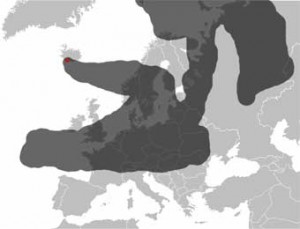
The Eyjafjallajökull ash cloud at 06:00 UTC
on 17 April 2010.
Source: Wikimedia Commons
On 14 April 2010 the Icelandic volcano Eyjafjallajökull erupted for a second time in two month after having been dormant for just under 200 years. The second eruption caused an ash plume that was ejected into the stratosphere and transported by the wind to Northwest Europe and all air traffic was shut down. As a result the eruption became a major news story. A secondary reason why the eruption became a major news story is the fact that volcanic ash clouds have not affected Europe in such an immediate way in living memory. But looking at the historical record of volcanic eruptions it becomes clear that these events have affected Europe and other parts of the world in significant ways and sometimes even altered the course of history. This extra edition of the Exploring Environmental History podcast considers a small sample of such volcanic event events, including the 536 AD dust veil event, the Black Death and the Laki eruption of 1783.
Resources and further reading
Nature as Historical Protagonist by Bruce M. S. Campbell, The Tawney Memorial Lecture 2008
Watch the lecture online
Gavin Schmidt, 536 AD and all that, RealClimate
L. B. Larsen et.al., “New ice core evidence for a volcanic cause of the A.D. 536 dust veil”, Geophysical Research Letters, Vol. 35, L04708, 5 PP., 2008.
R. A. Dodgshon, D. D. Gilbertson & J. P. Grattan, “Endemic stress, farming communities and the influence of Icelandic volcanic eruptions in the Scottish Highlands”, Geological Society, London, Special Publications; 2000; v. 171; p. 267-280.
Stephen Self, Icelandic eruptions, open2.net


Recent Comments